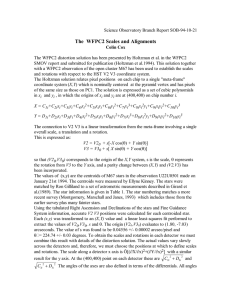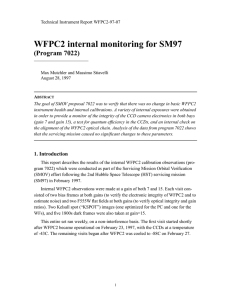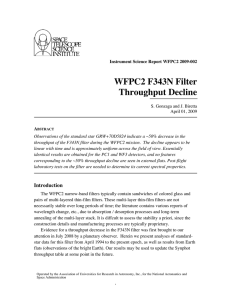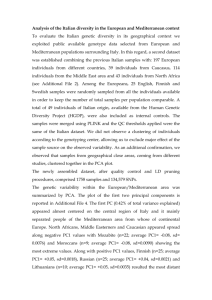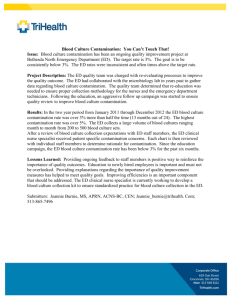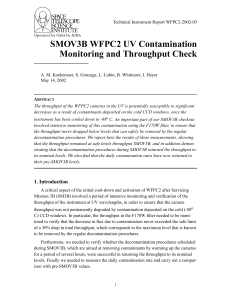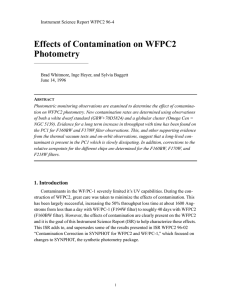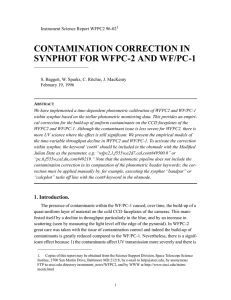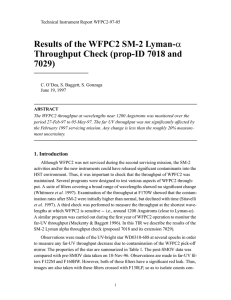WFPC2 Throughput Stability in the Extreme Ultraviolet
advertisement
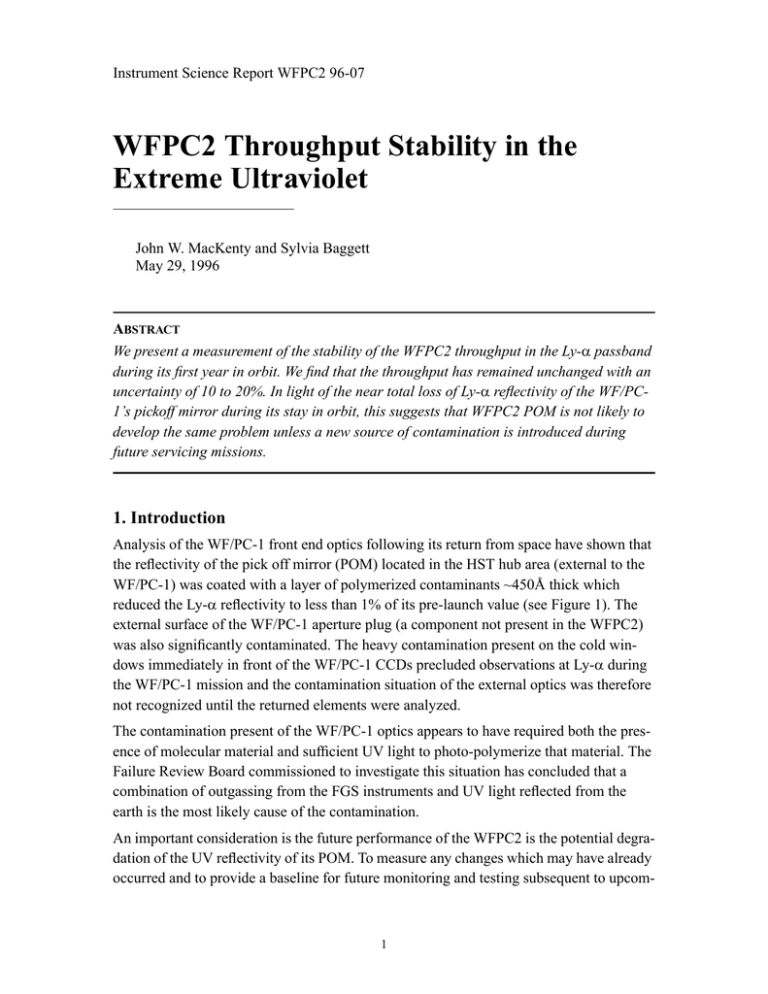
Instrument Science Report WFPC2 96-07 WFPC2 Throughput Stability in the Extreme Ultraviolet John W. MacKenty and Sylvia Baggett May 29, 1996 ABSTRACT We present a measurement of the stability of the WFPC2 throughput in the Ly-α passband during its first year in orbit. We find that the throughput has remained unchanged with an uncertainty of 10 to 20%. In light of the near total loss of Ly-α reflectivity of the WF/PC1’s pickoff mirror during its stay in orbit, this suggests that WFPC2 POM is not likely to develop the same problem unless a new source of contamination is introduced during future servicing missions. 1. Introduction Analysis of the WF/PC-1 front end optics following its return from space have shown that the reflectivity of the pick off mirror (POM) located in the HST hub area (external to the WF/PC-1) was coated with a layer of polymerized contaminants ~450Å thick which reduced the Ly-α reflectivity to less than 1% of its pre-launch value (see Figure 1). The external surface of the WF/PC-1 aperture plug (a component not present in the WFPC2) was also significantly contaminated. The heavy contamination present on the cold windows immediately in front of the WF/PC-1 CCDs precluded observations at Ly-α during the WF/PC-1 mission and the contamination situation of the external optics was therefore not recognized until the returned elements were analyzed. The contamination present of the WF/PC-1 optics appears to have required both the presence of molecular material and sufficient UV light to photo-polymerize that material. The Failure Review Board commissioned to investigate this situation has concluded that a combination of outgassing from the FGS instruments and UV light reflected from the earth is the most likely cause of the contamination. An important consideration is the future performance of the WFPC2 is the potential degradation of the UV reflectivity of its POM. To measure any changes which may have already occurred and to provide a baseline for future monitoring and testing subsequent to upcom- 1 ing servicing missions, we have obtained observations of a spectrophotometric standard star in the Ly-α passband. This report describes these observations and their implications. Figure 1: Pre- and Post-Flight POM Reflectivity 2. Experimental Method Contamination Spectrum A property of most thin layer contamination situations is that the transmission spectrum appears as a smoothed discontinuity with very little transmission at wavelengths shortwards of the transition wavelength and essentially normal transmission at longer wavelengths. As the layer increases in thickness, the transition wavelength increases. The observed performance therefore shows an initial decline at the shortest wavelengths followed by the spread of the problem to longer wavelengths over time. Therefore measurements designed to detect relatively small amounts of contamination and to recognize a problem at its onset should be conducted at the shortest available wavelengths. Standard Star Observations We obtained observations of the standard star BD+75D325 (an O5 star) in the F122M (Ly α filter) at two different epochs. This star was first observed with WFPC2 in February 1994 and March 1994 approximately 2 months after WFPC2 was installed into HST 2 (SMOV 4763: Trauger). It was re-observed in December 1994 and January 1995 (CY4/ CAL 5778: MacKenty). This provides a measurement baseline covering WFPC2’s first year in orbit. This star is a strong UV source and, having been used extensively as a photometric standard by HST, is known to have constant flux over time. The particulars of the observations are listed in Table 1 Table 1. Observations of BD+75D325 Date Dataset Name ExpTime Detector Filter1 Filter2 1994 Feb 27 u23e5408t 1.4 PC1 F122M 1994 Feb 27 u23e5401t 1.4 WF3 F122M 1994 Mar 13 u23e6108t 1.4 PC1 F122M 1994 Mar 13 u23e6101t 1.4 WF3 F1224M 1994 Dec 22 u2170101t 3.0 PC1 F122M 1994 Dec 22 u2170102t 3.0 PC1 F122M 1994 Dec 22 u2170105t 3.0 WF3 F122M 1994 Dec 22 u2170106t 3.0 WF3 F122M 1994 Dec 22 u2170103t 5.0 PC1 F122M F130LP 1994 Dec 22 u2170104t 5.0 PC1 F122M F130LP 1994 Dec 22 u2170107t 5.0 WF3 F122M F130LP 1994 Dec 22 u2170108t 5.0 WF3 F122M F130LP 1995 Jan 06 u2170201t 3.0 PC1 F122M 1995 Jan 06 u2170202t 3.0 PC1 F122M 1995 Jan 06 u2170205t 3.0 WF3 F122M 1995 Jan 06 u2170206t 3.0 WF3 F122M 1995 Jan 06 u2170203t 5.0 PC1 F122M F130LP 1995 Jan 06 u2170204t 5.0 PC1 F122M F130LP 1995 Jan 06 u2170207t 5.0 WF3 F122M F130LP 1995 Jan 06 u2170208t 5.0 WF3 F122M F130LP Redleak Compensation Since the F122M filter has a large red leak, we also obtained observations of the same star during the second epoch observations (late 1994 and early 1995) with the F122M filter in combination with the F130LP filter. The F130LP effectively blocks all flux shortwards of 130 nm. This permits a direct measurement of the redleak under the assumption that the 3 long wavelength throughput of the WFPC2 has not changed. Slightly more than have of the observed flux in the F122M filter is found to be redleak. Internal Contamination Compensation Since WFPC2 contains sufficient internal contaminants to reduce the 170 nm throughput by approximately 1% per day, the 122 nm throughput is presumably attenuated by at least that much. These contaminants also effect the redleak to some extent. Rather than attempting to directly calculate the effects of the internal contaminants, we elected to control for them by obtaining the differential 122 nm measurements with the internal contaminants in the same state. This is possible because WFPC2 is decontaminated on a 28 day cycle. The decontamination removes the material built up on the cold (-88o C) windows mounted immediately in front of each CCD detector and appears to fully restore the UV performance. The first epoch observations were obtained on dates 5 and 19 days subsequent to a decontamination. The 22 December 1994 and 6 January 1995 observations were therefore matched to the same point in the decontamination cycle. It is important to note that the decontamination cycle has undergone exhibited some changes over WFPC2 lifetime. During the first several months in orbit there was a gradual decline in the rate of contaminant buildup. Also, during the first epoch observations the CCD operating temperature was set at -78o C. The warmer setpoint could conceivable effect both the rate of growth of the contaminant layer and its composition. We believe that these effects are small and do not change our final conclusions. Detector Response Changes and Compensation The WFPC2 CCDs have a charge transfer efficiency problem which was discovered after its installation into HST. The problem was largely circumvented by lowering the operating temperature of the CCD detectors from -78o C to -88o C on 23 April 1994. However, since the first epoch 122 nm observations were obtained prior to this date, we must correct for the signal loss which was present in these observations. Photometric monitoring in the F170W, F218W, and F255W passbands showed an increase in sensitivity at the center of PC1 of 5% to 8% and approximately 5% for WF3 (with considerably more scatter) when the operating temperature was reduced. Flux Measurements Each frame was manually edited for cosmic ray events and the flux in a 5 pixel radius aperture was measured. The small radius was selected since contamination might cause scattering as well as absorption. The mean of an annulus centered on the star was subtracted to correct for any residual background removal errors. The measured fluxes, 4 expressed as count rates (DN s-1) are given in Table 2. Observations with potential problems are marked with an “:”. 3. Results Table 2. Observed Count Rates Date PC1 F122M WF3 F122M+F130LP F122M F122M+F130LP 1994 Feb 27 1248 1580 1994 Dec 22 1454 712 1594 890 1994 Dec 22 1471 717 1643 886 1994 Mar 13 1172 1995 Jan 06 1159 548: 1147 603 1995 Jan 06 1173 550 1163 616 1443 As expected, the redleak flux declines from day 5 to day 19 in the decontamination cycle since the F122M redleak includes a significant component in the UV when observing a hot star. Averaging the observations obtained on the same dates, increasing the first epoch count rates by 5% in both for both PC1 and WF3 (to account for the CTE improvement from lowering the CCD operating temperature), and subtracting the measured redleaks, we find the results shown in Table 3. Table 3. Corrected Count Rates Epoch Decon Phase PC1 WF3 1 +5 595 771 2 +5 748 731 +26% -5% Change 1 +19 623 834 2 +19 617 547 -1% -34% Change It is interesting to note that the decline with decontamination phase expected in the 122 nm passband is 18% in PC1 and 25% in WF3 for the second epoch observations but that 5 this decline is not present in the first epoch observations. This casts some doubt on the assumption that the decontaminations are sufficiently repeatable to make a high precision of the 122 nm throughput. 4. Conclusions and Recommendations To the limits of these measurements, the 122 nm throughput of the WFPC2 has remained constant during its first year in orbit. It appears likely that this test would detect a decline in reflectivity in the POM comparable to that experienced by WF/PC-1 during its first year in orbit even if we assume that the WF/PC-1’s contamination had been deposited at a uniform rate during its 3.5 years in orbit. Since it is very likely that the WF/PC-1 external contamination deposition rate decreased with time we may still have the contamination situation present when the WF/PC-1 was removed. The detection of a clear signal at 122 nm implies that the surface of the POM has not been significantly degraded since the installation of the flight mirror at JSC. It would be prudent to repeat these measurements annually. A test in late 1995 or early 1996 should determine if the apparently large systematic errors arise from the internal contamination environment during the early phases of the WFPC2’s deployment (which is our suspicion). It would also be prudent to repeat this test before and immediately following each future servicing mission in conjunction with a more extended monitoring of the UV performance of WFPC2 (e.g. F170W). Such monitoring is necessary both to access the state of the POM and the internal contamination on the CCD windows. 6
